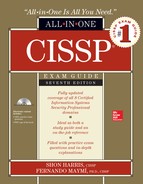Book Description
Completely revised and updated for the 2015 CISSP body of knowledge, this new edition by Fernando Maymì continues Shon Harris’s bestselling legacy, providing a comprehensive overhaul of the content that is the leading chosen resource for CISSP exam success, and has made Harris the #1 name in IT security certification.
This bestselling self-study guide fully prepares candidates for the challenging Certified Information Systems Security Professional exam and offers 100% coverage of all eight exam domains. This edition has been thoroughly revised to cover the new CISSP 2015 Common Body of Knowledge, including new hot spot and drag and drop question formats, and more.
Each chapter features learning objectives, exam tips, practice questions, and in-depth explanations. Beyond exam prep, the guide also serves as an ideal on-the-job reference for IT security professionals. CISSP All-in-One Exam Guide, Seventh Edition provides real-world insights and cautions that call out potentially harmful situations.
- Fully updated to cover the 8 new domains in the 2015 CISSP body of knowledge
- Written by leading experts in IT security certification and training
- Features new hot spot and drag-and-drop question formats
- Electronic content includes 1400+ updated practice exam questions
